How many times is the Gateway Arch in St. Louis struck by lightning each year?
|
In September of 2025, my work is generating the most income it ever has in my career. Yet, I'm being forced to shut down my successul operation, against my will, due to one cause alone: 95% of that revenue is being stolen by piracy and copyright infringement. I've lost more than $1 million to copyright infringement in the last 15 years, and it's finally brought an end to my professional storm chasing operation. Do not be misled by the lies of infringers, anti-copyright activists and organized piracy cartels. This page is a detailed, evidenced account of my battle I had to undertake to just barely stay in business, and eventually could not overcome. It's a problem faced by all of my colleagues and most other creators in the field. |
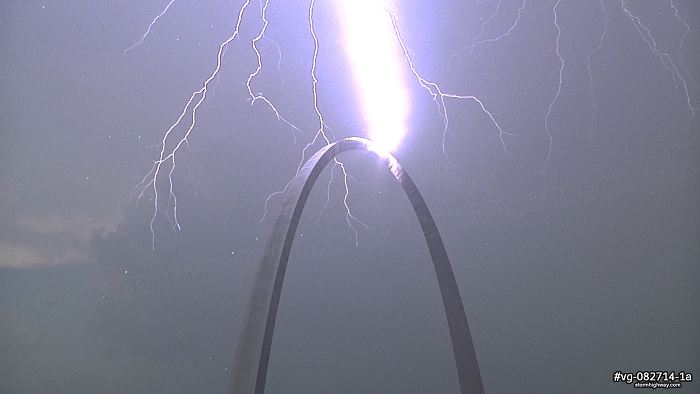
Lightning strikes the Gateway Arch on August 27, 2014
The Short Answer: The Gateway Arch is struck by lightning once or twice in the average year. Some years, it is not hit at all.
The Long Answer: I have been intensively covering St. Louis storms since January of 2010, and my photography and video operations result in having a camera on the Arch for the duration of most storms downtown. My gallery of photos shows the results from that effort. The consequence of this ongoing project is that I have a directly-observed count of Arch strikes over the ten-year period from 2010 to 2023. Since 2010, there have only been a total of nine verifiable full lightning strikes to the Gateway Arch (average of less than once per year), with some years seeing no strikes at all. Three of those nine strikes occured in less than one hour during the exceptionally rare July 19, 2020 storm.
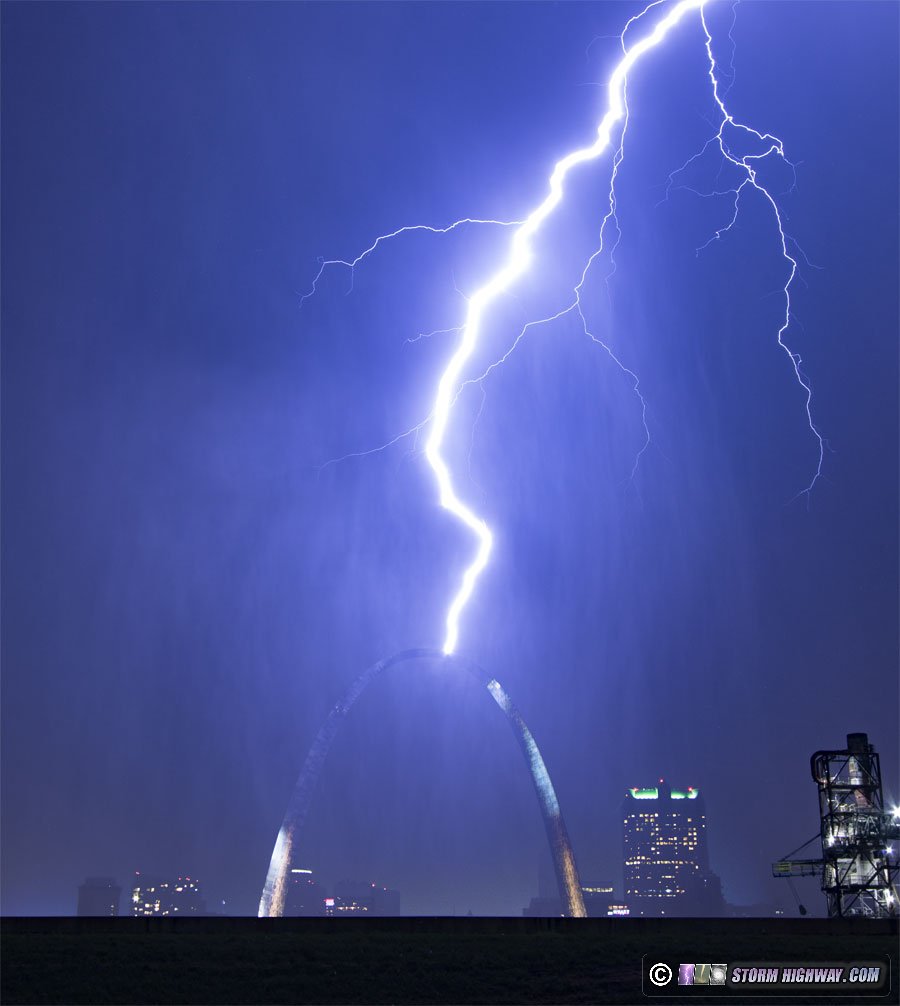
Lightning strikes the Arch on June 30, 2023.
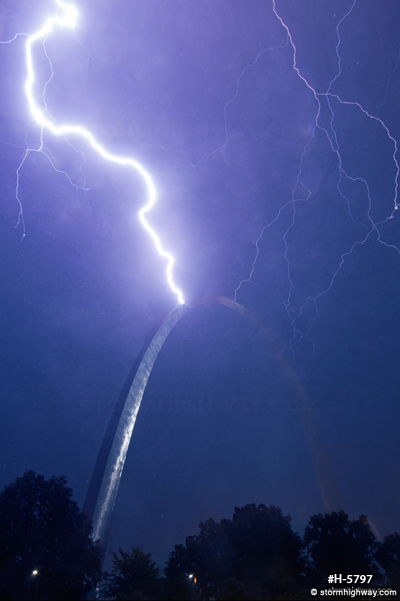
Lightning strikes the Arch for the third time in an hour during a rare storm on July 19, 2020.
Despite my efforts, I had an almost legendary record of missing Arch strikes: Until July of 2020, I was only 2 for 5 on captures, regardless of the almost obsessive effort to be there for every storm. I didn't capture the Arch getting hit until August 27, 2014, and it took me TEN YEARS to finally capture a nighttime high-quality DSLR still image of an Arch strike on July 19, 2020! The bottom line: it's conclusive from direct observation that the Arch is not the crazy lightning magnet that one might first assume.
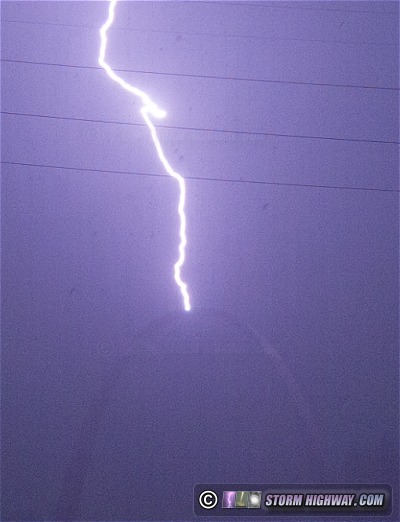
The first of three Arch strikes on July 19, 2020.
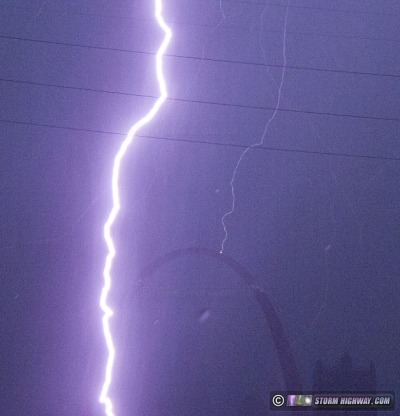
Lightning strikes the Arch for the second time in an hour on July 19, 2020.
Full strikes versus lightning leaders: Multiple upward leaders can initiate from ground-based objects in response to the descending stepped leader of an impending lightning strike. If a cloud-to-ground lightning bolt hits within a tenth of a mile or so from the Arch, an upward leader (a luminous channel of ionized air) will sometimes initiate from the Arch. I have captured two of these events during St. Louis storms:
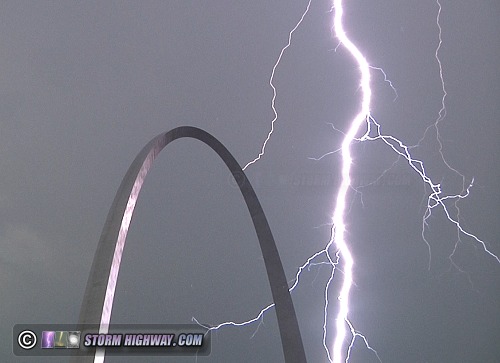
Lightning leader initiates from the Arch in response to the nearby lightning strike in the background - August 27, 2014.
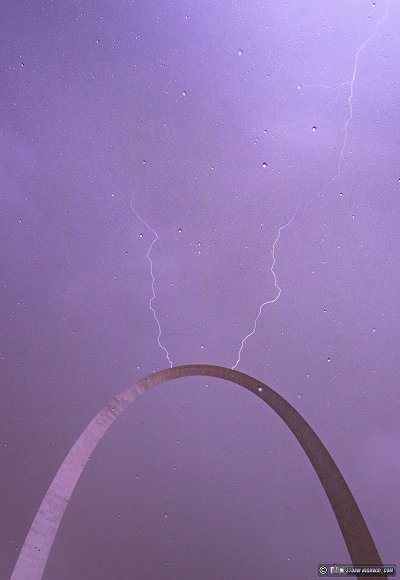
Two lightning leaders initiate from the Arch in response to a nearby lightning strike downtown - April 18, 2019.
It is common for direct strike events to the Arch to also initiate one or more of these upward leaders from another part of the structure, as happened during the third strike on July 19, 2020 (pictured above). For the purposes of this discussion, I don't count the leader-only events as true "full" lightning strikes, although one could make an argument for their inclusion.
List of all known Gateway Arch lightning strikes, 2010-2023
I've compiled this is a list of all known Gateway Arch lightning strikes (9) and upward leader events (2) since 2010, and my capture or reason for missing each one:
- April 10, 2013, missed: Still photo captured by Brad Krischel. Reason I missed: running live streaming shot for television client, missed the Arch strike by 30 seconds.
- August 27, 2014, captured: One full strike and one upward leader event. Video and frame captures.
- July 25, 2016, missed: video captured by Zachary Hall from the Hyatt hotel. Reason I missed: Bizarre storm behavior, east-moving storm suddenly reversed direction back over the city after I had returned home.
- July 3, 2018, captured: Captured on dashcam, but missed on quality cameras: the Arch strike bolt was the first one the storm produced.
- July 14, 2018, missed: Cell phone image captured by Cardinals game attendee. Reason I missed: Storm suddenly formed right over downtown, I could not arrive in time.
- April 18, 2019, leader event: Two lightning leaders initiate from the Arch in response to a close strike to the west downtown. I captured this event on a DSLR still.
- July 19, 2020, captured (3): 1500FPS video and DSLR still capture: The Arch was struck THREE TIMES in just under an hour during this incredibly rare prolific cloud-to-ground lightning barrage directly over downtown. Four strikes also occurred to the city's skyscrapers, including two to the U.S. Courthouse.
- June 30, 2023, captured: Video and DSLR still capture: Two supercell thunderstorms produced intense barrages of lightning over St. Louis after sunset this night. Downtown buildings were also struck, including One Metropolitan Square.
Known Arch strikes prior to 2010:
- August 16, 2009: Video captured by bystander from near Busch Stadium.
- July 4, 2005: Video captured by bystander from Hyatt hotel.
- 1980: Witnessed by photographer Joseph Matthews.
Upward and downward lightning
The Arch does certainly have a much higher probability of getting hit by cloud-to-ground (downward moving stepped leader) lightning in any given storm, that is, compared to other buildings and objects in the city. At 600 feet tall, all it needs is a stepped leader to descend within 600 feet or so of it, and the channel will likely connect to the structure. However, it appears that this might happen only once or twice a year (at best). The number may even be more like once every two years - particularly if the 2 to 3 storms a year I miss are like the other 10-15 per year I do observe.
As for upward (ground-to-cloud) lightning, the Arch is barely tall enough to initiate an upward lightning stroke (600 feet is very near the bottom of the height scale for towers to be good lightning leader initiators). I have observed and photographed many strong electrified stratiform lightning events over the Arch, none of which initiated even a short lightning leader from the structure. It could be that the Arch's curved profile doesn't allow for a focused "point" of electric field concentration like a tower antenna tip does. Or, it could be that the abundance of tall buildings nearby regionally distributes the EF buildup enough to prevent leader initiation. Whatever the cause, I can say with confidence that upward lightning strokes from the Arch are extremely rare if not nonexistent: there are no known examples of it happening.
Examples of prolific lightning events with no Arch strikes
A good case for Arch strike rates was on June 26 of 2011, when continuous thunderstorms raged over downtown St. Louis for several hours straight. I was there the whole time with cameras (still and video) on the Arch (having to stop to recharge camera batteries twice), and it was not hit! The closest a bolt came was this one, with not even a small leader initiated from the Arch itself:
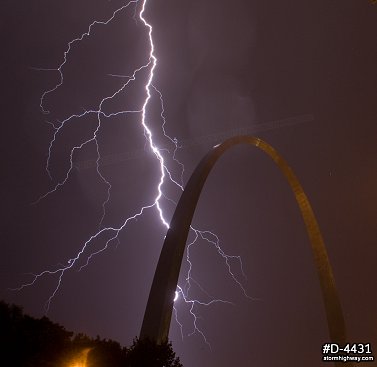
Then there were these two storms (September 18, 2010 and August 4, 2012), two of the most lightning-active I have observed over downtown since I've lived here (2010). No Arch hits during those either, not even a leader (both of these images are 8-frame stacks of multiple strikes):
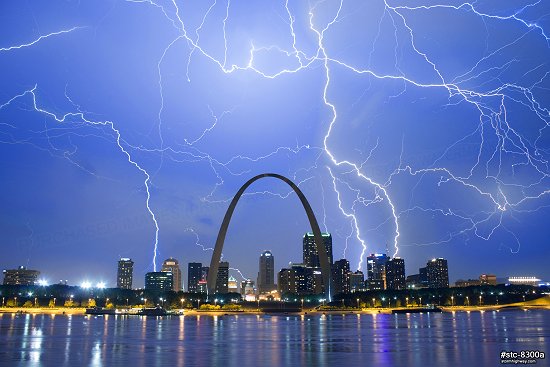 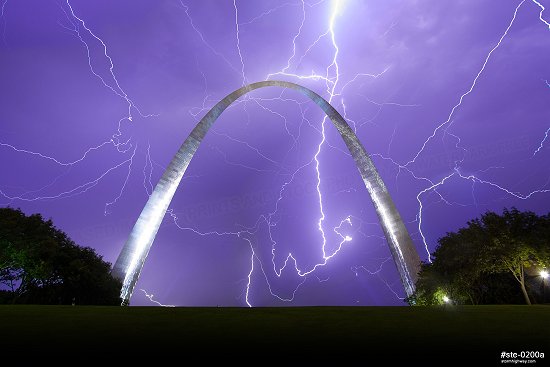
I have even more videos of St. Louis storms with no Arch strikes - this is a compilation of a half-dozen of the better lightning events over the city I've captured. And those good lightning events over the city themselves are quite rare - with most of my storm shoots in the city, I either captured no good lightning worth saving, or the storm didn't produce visible lightning at all (entirely within the clouds). Photogenic lightning over downtown is quite the rare event - maybe 3 or 4 times a year. My point being, only during the most insane barrages of cloud-to-ground lightning right over downtown St. Louis does the Arch stand a good chance of getting struck. That type of storm is not common anywhere - I chase storms all over the country and see such a barrage maybe once or twice a year!
I listed above the known Arch strike incidents. Yes, it's possible there could be others, but it's not likely. Again, I am there rolling video and stills for most St. Louis storms and can personally verify Arch strikes (or the lack thereof) during those. As a national landmark in a large city, the Arch is usually covered by at least one or two photographers or cell phone-using bystanders during your average storm. A lightning strike event to it will likely not go unpublicized (unless the photographer was never inclined to share his capture with anyone).
Conclusions
So, to sum all of this up, based on my personal observation of over 10 years (as of today in July 2023), I estimate that the Gateway Arch is hit by lightning only once or twice in the average year. I believe that there are some years when it is not hit at all - as is likely in 2011, 2012, 2017 and 2019. I'd maybe go as high as 5 times in a more active thunderstorm year - but nowhere near the figure of hundreds of times a year. The remarkable exception to all of this was the July 19, 2020 storm in which the Arch was struck three times in less than an hour, but again, that is something I've only seen once in the ten years I've been covering St. Louis storms.
Is it safe to be in the Arch when it is struck by lightning?
Yes. The Arch is a well-grounded steel structure. Lightning current from a direct strike flows harmlessly through the structure to the ground. Anyone in the observation deck at the top, in the trams, in the museum below or even standing next to it would not feel a thing! The thunder is quite loud and startling, however!
The exception might be that someone standing outside at the base of one of the legs while touching the structure *might* feel at least a mild shock at the time of a strike. However, again, since the structure is well-grounded, it's doubtful such a shock would be lethal. I'm not aware of anyone who has experienced that - but I wouldn't want to volunteer to be the first!
Events mistaken for Arch strikes
I have seen at least two high-profile images/videos (making the rounds on news broacasts and social media) incorrectly claiming to show the Arch being struck by lightning. One of these is from May 30, 2013 in a video taken from Busch Stadium. In that particular video, you can see the lightning continue on down past the top of the Arch, clearly hitting something behind it. I was on a storm expedition in Oklahoma that night and was not present for that event.
The other video I know of is from September 2012 taken from the Millenium Hotel that, again, shows a lightning bolt striking behind the Arch (hitting the Eads Bridge) but claims that the lightning hit the Arch. I was actually shooting video below the Arch on the riverfront for that particular storm, and witnessed the strike to the Eads - no bolt hit the Arch.
In both of these cases, the common factor was that the main channel of the bolt clearly goes behind the Arch. You can inspect for that kind of thing for any future events to determine whether there was actually a genuine direct hit.
 About the Author: Dan Robinson has been a storm chaser, photographer and cameraman for 33 years. His career has involved traveling around the country covering the most extreme weather on the planet including tornadoes, hurricanes, lightning, floods and winter storms. Dan has been extensively published in newspapers, magazines, web articles and more, and has both supplied footage for and appeared in numerous television productions and newscasts. He has also been involved in the research community, providing material for published scientific journal papers on tornadoes and lightning. |
The Arch got struck by lightning last night (April 10th, 2013). Did you happen to catch it?
- Posted by Kyle from St Louis | | |
Kyle, I missed it by 30 seconds. I was there but didn't get set up in time.
- Posted by Dan R. from New Baden, IL | | |
when will the time capsual be opened
- Posted by Brenda Satterfield | | |
Hi Dan, Having grown up in Alton, Ill., I'm glad to see someone as interested in the weather there as I am. St. Louis is, IMHO, the nation's best kept secret in terms of a Cool place to live and work and visit. Keep up the great work, Dan. Cheers, Larry
- Posted by Larry Mager from Fairborn, Ohio | | |
|